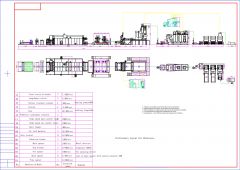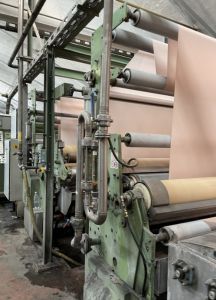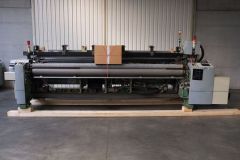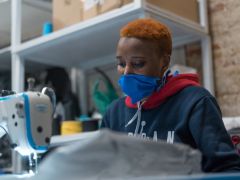Search results for: 'combined c'
- Related search terms
- Combined
- combined cycle
- COMBINED CYCLE COMPLETE POWER PLANT
- combined+cycle
- combined data
-
 YY-2251 AIRLAID PRODUCTION LINE, FINAL PRODUCT WIDTH 2200mmYY-2251 AIRLAID PRODUCTION LINE, FINAL PRODUCT WIDTH 2200mm ITEM 001 BALE OPENER (2 SETS) AND SEALED BALE OPENER (1 SET) ITEM 002 FIBER OPENING MACHINE (FOR LOW MELT FIBER OR PP) - 1 SET ITEM 003 PRE-OPENER – 1 SET ITEM 004 BIG CHAMBER BLENDER – 1 SET ITEM 005 MAIN-OPENER – 1 SET ITEM 006 VIBRATING FEEDER – 1 SET ITEM 007 CONDENSER – 2 SETS ITEM 008 AUTO-LEVER - 1 SET ITEM 009 AIR LAID MACHINE – 1 SET ITEM 010 AUTO-LEVER – 1 SET ITEM 011 BATT FEEDER – 1 SET ITEM 012 HIGH SPEED SINGLE SHAFT SINGLE BOARD PRE NEEDLE LOOM – 1 SET ITEM 013 HIGH SPEED SINGLE SHAFT SINGLE BOARD MAIN NEEDLE LOOM – 1 SET ITEM 014 DOUBLE BELT THERMAL-BONDED OVEN – 1 SET ITEM 015 DOUBLE-ROLLER CALENDER MACHINE – 1 SET ITEM 016 COOLING UNIT – 1 SET Learn More
YY-2251 AIRLAID PRODUCTION LINE, FINAL PRODUCT WIDTH 2200mmYY-2251 AIRLAID PRODUCTION LINE, FINAL PRODUCT WIDTH 2200mm ITEM 001 BALE OPENER (2 SETS) AND SEALED BALE OPENER (1 SET) ITEM 002 FIBER OPENING MACHINE (FOR LOW MELT FIBER OR PP) - 1 SET ITEM 003 PRE-OPENER – 1 SET ITEM 004 BIG CHAMBER BLENDER – 1 SET ITEM 005 MAIN-OPENER – 1 SET ITEM 006 VIBRATING FEEDER – 1 SET ITEM 007 CONDENSER – 2 SETS ITEM 008 AUTO-LEVER - 1 SET ITEM 009 AIR LAID MACHINE – 1 SET ITEM 010 AUTO-LEVER – 1 SET ITEM 011 BATT FEEDER – 1 SET ITEM 012 HIGH SPEED SINGLE SHAFT SINGLE BOARD PRE NEEDLE LOOM – 1 SET ITEM 013 HIGH SPEED SINGLE SHAFT SINGLE BOARD MAIN NEEDLE LOOM – 1 SET ITEM 014 DOUBLE BELT THERMAL-BONDED OVEN – 1 SET ITEM 015 DOUBLE-ROLLER CALENDER MACHINE – 1 SET ITEM 016 COOLING UNIT – 1 SET Learn More -
 TT-1191 BABCOCK STENTER FRAME, PIN CHAIN, WORKING WIDTH 3200mm, YEAR 1988TT-1191 BABCOCK STENTER FRAME, PIN CHAIN, WORKING WIDTH 3200mm, YEAR 1988 BABCOCK STENTER FRAME WIDTH 3400mm WORKING WIDTH 3200mm YEAR 1988 7 CHAMBERS RUNNING ON FACTORY FLOOR INVERTORS DRIVEN EXCELLENT CONDITION QUANTITY: 1 Learn More
TT-1191 BABCOCK STENTER FRAME, PIN CHAIN, WORKING WIDTH 3200mm, YEAR 1988TT-1191 BABCOCK STENTER FRAME, PIN CHAIN, WORKING WIDTH 3200mm, YEAR 1988 BABCOCK STENTER FRAME WIDTH 3400mm WORKING WIDTH 3200mm YEAR 1988 7 CHAMBERS RUNNING ON FACTORY FLOOR INVERTORS DRIVEN EXCELLENT CONDITION QUANTITY: 1 Learn More -
 TT-1170 PICANOL OMNIPLUS-4-P-340 AIR JET LOOMS, WORKING WIDTH 3400mm, YEAR 2000, CAMTT-1170 PICANOL OMNIPLUS-4-P-340 AIR JET LOOMS, WORKING WIDTH 3400mm, YEAR 2000, CAM BRAND: PICANOL TYPE: OMNIPLUS-4-P-340 YEAR 2000 WORKING WIDTH: 3400mm 4 COLORS CAM BOX STAUBLI TYPE 1751A QUANTITY: 3 Learn More
TT-1170 PICANOL OMNIPLUS-4-P-340 AIR JET LOOMS, WORKING WIDTH 3400mm, YEAR 2000, CAMTT-1170 PICANOL OMNIPLUS-4-P-340 AIR JET LOOMS, WORKING WIDTH 3400mm, YEAR 2000, CAM BRAND: PICANOL TYPE: OMNIPLUS-4-P-340 YEAR 2000 WORKING WIDTH: 3400mm 4 COLORS CAM BOX STAUBLI TYPE 1751A QUANTITY: 3 Learn More -
 D-2388 What’s the Best Material for a Mask?
D-2388 What’s the Best Material for a Mask?Federal health officials have now recommended that we cover our faces with fabric during the coronavirus pandemic. But what material offers the most protection?
The Centers for Disease Control and Prevention has posted a no-sew mask pattern using a bandanna and a coffee filter as well as a video on making masks using rubber bands and folded fabrics found at home.
While a simple face covering can reduce the spread of coronavirus by blocking outgoing germs from coughs or sneezes of an infected person, experts say there is more variation in how much homemade masks might protect the wearer from incoming germs, depending on the fit and quality of the material used.
Scientists around the country have taken it upon themselves to identify everyday materials that do a better job of filtering microscopic particles. In recent tests, HEPA furnace filters scored well, as did vacuum cleaner bags, layers of 600-count pillowcases and fabric similar to flannel pajamas. Stacked coffee filters had medium scores. Scarves and bandanna material had the lowest scores, but still captured a small percentage of particles.
If you don’t have any of the materials that were tested, a simple light test can help you decide whether a fabric is a good candidate for a mask.
“Hold it up to a bright light,” said Dr. Scott Segal, chairman of anesthesiology at Wake Forest Baptist Health who recently studied homemade masks. “If light passes really easily through the fibers and you can almost see the fibers, it’s not a good fabric. If it’s a denser weave of thicker material and light doesn’t pass through it as much, that’s the material you want to use.”
Researchers say it’s important to remember that lab studies are conducted under perfect conditions with no leaks or gaps in the mask, but the test methods give us a way to compare materials. And while the degree of filtration for some homemade masks seems low, most of us — who are staying home and practicing social distancing in public — don’t need the high level of protection required for medical workers. More important, any face covering is better than none, especially if worn by a person who has the virus but doesn’t know it.
The biggest challenge of choosing a homemade mask material is to find a fabric that is dense enough to capture viral particles, but breathable enough that we can actually wear it. Some items being touted online promise high filtration scores, but the material would be unwearable.
Dressing Up for Work … at Home
Yang Wang, an assistant professor of environmental engineering at Missouri University of Science and Technology, worked with his graduate students to study various combinations of layered materials — including both air filters and fabric. “You need something that is efficient for removing particles, but you also need to breathe,” said Dr. Wang, who last fall won an international award for aerosol research.To test everyday materials, scientists are using methods similar to those used to test medical masks, which everybody agrees should be saved for medical workers who are exposed to high doses of virus from seeing infected patients. The best medical mask — called the N95 respirator — filters out at least 95 percent of particles as small as 0.3 microns. By comparison, a typical surgical mask — made using a rectangular piece of pleated fabric with elastic ear loops — has a filtration efficiency ranging from 60 to 80 percent.
Dr. Wang’s group tested two types of air filters. An allergy-reduction HVAC filter worked the best, capturing 89 percent of particles with one layer and 94 percent with two layers. A furnace filter captured 75 percent with two layers, but required six layers to achieve 95 percent. To find a filter similar to those tested, look for a minimum efficiency reporting value (MERV) rating of 12 or higher or a microparticle performance rating of 1900 or higher.
The problem with air filters is that they potentially could shed small fibers that would be risky to inhale. So if you want to use a filter, you need to sandwich the filter between two layers of cotton fabric. Dr. Wang said one of his grad students made his own mask by following the instructions in the C.D.C. video, but adding several layers of filter material inside a bandanna.
Dr. Wang’s group also found that when certain common fabrics were used, two layers offered far less protection than four layers. A 600 thread count pillow case captured just 22 percent of particles when doubled, but four layers captured nearly 60 percent. A thick woolen yarn scarf filtered 21 percent of particles in two layers, and 48.8 percent in four layers. A 100 percent cotton bandanna did the worst, capturing only 18.2 percent when doubled, and just 19.5 percent in four layers.
The group also tested Brew Rite and Natural Brew basket-style coffee filters, which, when stacked in three layers, showed 40 to 50 percent filtration efficiency — but they were less breathable than other options.
If you are lucky enough to know a quilter, ask them to make you a mask. Tests performed at the Wake Forest Institute for Regenerative Medicine in Winston-Salem, N.C., showed good results for homemade masks using quilting fabric. Dr. Segal, of Wake Forest Baptist Health, who led the study, noted that quilters tend to use high-quality, high-thread count cotton. The best homemade masks in his study were as good as surgical masks or slightly better, testing in the range of 70 to 79 percent filtration. Homemade masks that used flimsier fabric tested as low as 1 percent filtration, Dr. Segal said.
The best-performing designs were a mask constructed of two layers of high-quality, heavyweight “quilter’s cotton,” a two-layer mask made with thick batik fabric, and a double-layer mask with an inner layer of flannel and outer layer of cotton.
Bonnie Browning, executive show director for the American Quilter’s Society, said that quilters prefer tightly woven cottons and batik fabrics that stand up over time. Ms. Browning said most sewing machines can handle only two layers of fabric when making a pleated mask, but someone who wanted four layers of protection could wear two masks at a time.
Ms. Browning said she recently reached out to quilters on Facebook and heard from 71 people who have made a combined total of nearly 15,000 masks. “We quilters are very much in the thick of what’s going on with this,” said Ms. Browning, who lives in Paducah, Ky. “One thing most of us have is a stash of fabric.”
People who don’t sew could try a folded origami mask, created by Jiangmei Wu, assistant professor of interior design at Indiana University. Ms. Wu, who is known for her breathtaking folded artwork, said she began designing a folded mask out of a medical and building material called Tyvek, as well as vacuum bags, after her brother in Hong Kong, where mask wearing is common, suggested it. (DuPont, the maker of Tyvek, said in a statement that Tyvek is intended for medical apparel, not masks.) The folded mask pattern is free online, as is a video demonstrating the folding process. In tests at Missouri University and University of Virginia, scientists found that vacuum bags removed between 60 percent and 87 percent of particles. But some brands of vacuum bags may contain fiberglass or are harder to breathe through than other materials, and shouldn’t be used. Ms. Wu used a bag by EnviroCare Technologies, which has said it does not use fiberglass in its paper and synthetic cloth bags.
“I wanted to create an alternative for people who don’t sew,” said Ms. Wu, who said she is talking to various groups to find other materials that will be effective in a folded mask. “Given the shortage of all kinds of materials, even vacuum bags might run out.”
The scientists who conducted the tests used a standard of 0.3 microns because that is the measure used by the National Institute for Occupational Safety and Health for medical masks.
Linsey Marr, a Virginia Tech aerosol scientist and an expert in the transmission of viruses, said the certification method for respirators and HEPA filters focuses on 0.3 microns because particles around that size are the hardest to catch. While it seems counterintuitive, particles smaller than 0.1 microns are actually easier to catch because they have a lot of random motion that makes them bump into the filter fibers, she said.
“Even though coronavirus is around 0.1 microns, it floats around in a wide range of sizes, from around 0.2 to several hundred microns, because people shed the virus in respiratory fluid droplets that also contain lots of salts and proteins and other things,” said Dr. Marr. “Even if the water in the droplets fully evaporates, there’s still a lot of salt and proteins and other gunk that stays behind as solid or gel-like material. I think 0.3 microns is still useful for guidance because the minimum filtration efficiency will be somewhere around this size, and it’s what NIOSH uses.”
Learn More -
 L-3886 CHICKEN FEED PRODUCTION LINE
L-3886 CHICKEN FEED PRODUCTION LINEREFERENCE NUMBER: L-3886
Learn More
1) RECEIVING PROCESS
HEIGHT: 12 METERS
POWER: 1.5 KW
2) GRINDING AND MIXING PROCESS
LENGTH: 1.5 METERS
POWER: 1.5 KW
3) PELLETIZING AND BAGGING PROCESS
CAPACITY: 2 TO 3 TONS PER HOUR, PER UNIT
POWER: 37 KW
4) AUXILIARY PROCESS
POWE: 1.5 KW
5) ELECTRIC CONTROL SYSTEM
POWER: 3 PHASE, 380 VOLTS, 50 Hz -
 P-5068 SAN FRANCISCAN 12 KILOS 25 POUNDS ROASTER
P-5068 SAN FRANCISCAN 12 KILOS 25 POUNDS ROASTERP-5068 SAN FRANCISCAN 12 KILOS 25 POUNDS ROASTER
INCLUDES ROASTER, AFTERBURNER, AMBIENT AND BEAN TEMPERATURE PROBES WITH DUAL DIGITAL DISPLAY. ALSO, THE
HIGH QUALITY GAS MANIFOLD ALLOWS YOU TO MEASURE THE BTU INPUT. COMES CHAFF COLLECTOR. BOTH THE AFTERBURNER AND CHAFF COLLECTOR ARE COMBINED IN THE CYLINDER BEHIND THE ROASTER. EXCELLENT, AFFORDABLE CHOICE FOR THE CONTINUOUS COFFEE ROASTER. IT ROASTS AND COOLS AT THE SAME TIME. 4 BATCHES/HOUR. MINIMAL MAINTENANCE. PIPES ARE BUILT ON THE EXTERIOR SO EASY TO CLEAN. TERMS: 50% DEPOSIT AND BALANCE PRIOR TO SHIPMENT. ALLOW 60-90 DAYS FOR ASSEMBLY!SPECIFICATIONS:
36 INCHES X 96 INCHES FLOOR SPACE REQUIRED
4 BATCHES/HR =100 LBS/HR
VOLTAGE 220V SINGLE PHASE
AMPS 15 AMPS
BTU 100,000
GAS PRESSURE: 7 INCHES W/C NAT GAS OR 11 INCHES W/C PROPANE
FACE PLATES: 5/8 INCHES STEEL
WEIGHT 1350 LBS ROASTER + AFTERBURNER= 2100 LBSQUANTITY: 1
Learn More -
 STENTER FRAME MAKE BRUCKNER TYPE H/N 32/6 YEAR OF MAKE 2007 3400mmROLLER WIDTH 3400 mm SUITABLE FOR FABRIC WIDTH OF 3200 mm, HORIZONTAL COMBINED PIN AND CLIP CHAIN WITH 6 CHAMBERS GAS HEATED, COMPRISING OUT OF HIGH CLOTH FEEDING DEVICE FROM A-FRAME OR PLAITED FABRICS, STAINLESS STEEL GUIDING AND DEVIATING ROLLERS AND ENTRANCE INTO MAHLO WEFT/BOW STRAIGHTENER RVMC 12/3200, ENTRANCE INTO STENTER FRAME WITH OPTOELECTRONIC WIDTH CONTROL MAKE ERHARDT & LEIMER FR SERIES, ENTRANCE CHAIN 3 MTR, 6 CHAMBERS GAS HEATED, MECHANICAL MACHINE SPEED 5-100 M/MIN, HEAT RECOVERY DEVICE, DELIVERY OF FABRIC ONTO BIG BATCHING MOTION WITH PREINSTALLED COOLING CYLINDER, EXIT 3 MTR LONG, SPLIT FLOW SYSTEM FOR UPPER AND LOWER HEATING OF FABRIC, MACHINE IS WITHOUT PAD MANGLE. Learn More
STENTER FRAME MAKE BRUCKNER TYPE H/N 32/6 YEAR OF MAKE 2007 3400mmROLLER WIDTH 3400 mm SUITABLE FOR FABRIC WIDTH OF 3200 mm, HORIZONTAL COMBINED PIN AND CLIP CHAIN WITH 6 CHAMBERS GAS HEATED, COMPRISING OUT OF HIGH CLOTH FEEDING DEVICE FROM A-FRAME OR PLAITED FABRICS, STAINLESS STEEL GUIDING AND DEVIATING ROLLERS AND ENTRANCE INTO MAHLO WEFT/BOW STRAIGHTENER RVMC 12/3200, ENTRANCE INTO STENTER FRAME WITH OPTOELECTRONIC WIDTH CONTROL MAKE ERHARDT & LEIMER FR SERIES, ENTRANCE CHAIN 3 MTR, 6 CHAMBERS GAS HEATED, MECHANICAL MACHINE SPEED 5-100 M/MIN, HEAT RECOVERY DEVICE, DELIVERY OF FABRIC ONTO BIG BATCHING MOTION WITH PREINSTALLED COOLING CYLINDER, EXIT 3 MTR LONG, SPLIT FLOW SYSTEM FOR UPPER AND LOWER HEATING OF FABRIC, MACHINE IS WITHOUT PAD MANGLE. Learn More -
 TT-8654 SIEMENS SGT 5/6-2000E (94.2) POWER GENERATION, 498 MW, GAS FIRED, 60 HzTT-8654 SIEMENS SGT 5/6-2000E (94.2) POWER GENERATION, 498 MW, GAS FIRED, 60 Hz 1. POWER GENERATION 498 MW TOTAL 2. GAS FIRED 3. FREQUENCY (60 Hz) 4. MODEL: SIEMENS SGT5/6-2000E (VERSION 94.2) 5. OUTPUT: 166 MW PER UNIT (BASE LOAD) 6. CONFIGURATION: SIMPLE CYCLE; CONVERTIBLE TO COMBINED CYCLE OR CHP 7. FUEL: NATURAL GAS (OTHER FUELS POSSIBLE WITH MODIFICATION) 8. CONDITION: BRAND NEW, NEVER USED, ZERO HOURS 9. SERVICEABILITY: FULL SIEMENS OEM SUPPORT, GLOBAL SPARES AVAILABILITY, ROBUST INSTALLED BASE (SEPARATELY QUOTED SERVICE) QUANTITY: 3 Learn More
TT-8654 SIEMENS SGT 5/6-2000E (94.2) POWER GENERATION, 498 MW, GAS FIRED, 60 HzTT-8654 SIEMENS SGT 5/6-2000E (94.2) POWER GENERATION, 498 MW, GAS FIRED, 60 Hz 1. POWER GENERATION 498 MW TOTAL 2. GAS FIRED 3. FREQUENCY (60 Hz) 4. MODEL: SIEMENS SGT5/6-2000E (VERSION 94.2) 5. OUTPUT: 166 MW PER UNIT (BASE LOAD) 6. CONFIGURATION: SIMPLE CYCLE; CONVERTIBLE TO COMBINED CYCLE OR CHP 7. FUEL: NATURAL GAS (OTHER FUELS POSSIBLE WITH MODIFICATION) 8. CONDITION: BRAND NEW, NEVER USED, ZERO HOURS 9. SERVICEABILITY: FULL SIEMENS OEM SUPPORT, GLOBAL SPARES AVAILABILITY, ROBUST INSTALLED BASE (SEPARATELY QUOTED SERVICE) QUANTITY: 3 Learn More -
 TT-8276 SIEMENS SGT-800 TURBINES, 220 MW, YEAR 2025, 50/60 Hz (55MW each unit x 4) - NEWTT-8276 SIEMENS SGT-800 TURBINES, 220 MW, YEAR 2025, 50/60 Hz (55MW each unit x 4) - NEW 1. POWER GENERATION 220 MW 2. DUAL FUEL (NATURAL GAS / DIESEL) 3. DUAL FREQUENCY (60 Hz/ 50Hz) 4. SIEMENS SGT-800 TURBINES 5. YEAR OF MANUFACTURE: 2025 QUANTITY: 4 UNITS Learn More
TT-8276 SIEMENS SGT-800 TURBINES, 220 MW, YEAR 2025, 50/60 Hz (55MW each unit x 4) - NEWTT-8276 SIEMENS SGT-800 TURBINES, 220 MW, YEAR 2025, 50/60 Hz (55MW each unit x 4) - NEW 1. POWER GENERATION 220 MW 2. DUAL FUEL (NATURAL GAS / DIESEL) 3. DUAL FREQUENCY (60 Hz/ 50Hz) 4. SIEMENS SGT-800 TURBINES 5. YEAR OF MANUFACTURE: 2025 QUANTITY: 4 UNITS Learn More -
 TT-7850 JENBACHER JGS 620F NATURAL GAS GENERATOR SYSTEM, 6.712 MW TOTAL, 11KV, 1500 RPM, YEAR 2012TT-7850 JENBACHER JGS 620F NATURAL GAS GENERATOR SYSTEM, 6.712 MW TOTAL, 11KV, 1500 RPM, YEAR 2012 1. JENBACHER GENERATOR SYSTEM 2. CONSISTING OF (2) MODEL JGS 620F JENBACHER NATURAL GAS GENSETS. 3. EACH RATED 3.356 MW; 2.9 MW NET OUTPUT; 1500 RPM; 3/50/11KV. YEAR BUILT 2012. 4. REPORTED 20,000 HOURS ON EACH UNIT. CONTROLLED BY (1) PANEL. 5. BRAND: JENBACHER 6. MODEL: JGS 620F 7. USED EQUIPMENT FACTS ABOUT THIS MACHINE 8. BRAND: JENBACHER (BY INNIO) 9. MODEL: JGS 620F 10. FUEL TYPE: NATURAL GAS 11. YEAR BUILT: 2012 QUANTITY: 1 Learn More
TT-7850 JENBACHER JGS 620F NATURAL GAS GENERATOR SYSTEM, 6.712 MW TOTAL, 11KV, 1500 RPM, YEAR 2012TT-7850 JENBACHER JGS 620F NATURAL GAS GENERATOR SYSTEM, 6.712 MW TOTAL, 11KV, 1500 RPM, YEAR 2012 1. JENBACHER GENERATOR SYSTEM 2. CONSISTING OF (2) MODEL JGS 620F JENBACHER NATURAL GAS GENSETS. 3. EACH RATED 3.356 MW; 2.9 MW NET OUTPUT; 1500 RPM; 3/50/11KV. YEAR BUILT 2012. 4. REPORTED 20,000 HOURS ON EACH UNIT. CONTROLLED BY (1) PANEL. 5. BRAND: JENBACHER 6. MODEL: JGS 620F 7. USED EQUIPMENT FACTS ABOUT THIS MACHINE 8. BRAND: JENBACHER (BY INNIO) 9. MODEL: JGS 620F 10. FUEL TYPE: NATURAL GAS 11. YEAR BUILT: 2012 QUANTITY: 1 Learn More
